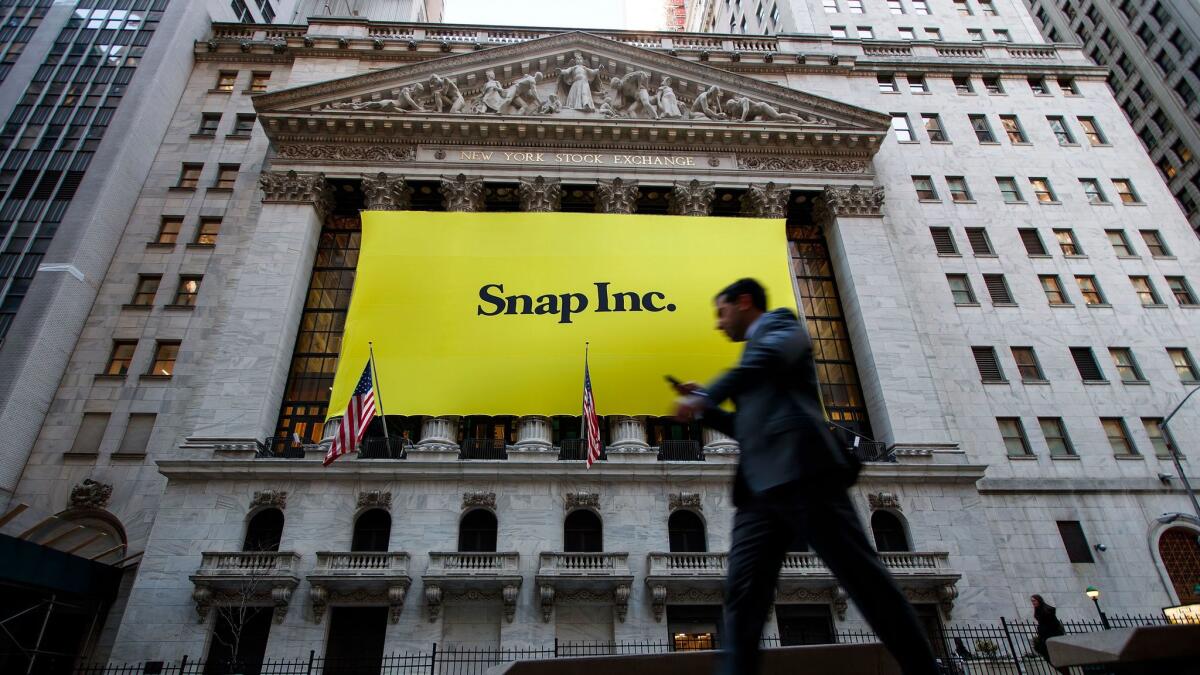Snap isn’t the only tech firm to get hammered after its first earnings report

- Share via
Reporting from San Francisco — Snap Inc.’s stock took a dive in after-hours trading Wednesday after the Los Angeles company reported its quarterly earnings, its first since going public in March. But this doesn’t necessarily spell doom and gloom for the maker of the popular Snapchat app — at least, not yet.
It’s not unusual for tech stocks to take a hit shortly after an initial public offering. And it’s not uncommon, says Goodwater Capital managing partner Eric Kim, for that hit to occur after the company issues its first earnings report.
It often takes a while, Kim said, for markets to adjust their expectations and figure out what a company is actually worth.
Facebook stock fell more than 10% after it reported its first quarterly earnings in 2012. Twitter stock fell 22% when it reported its earnings in 2014. And after Snap’s first earnings call Wednesday, in which it reported slowing user growth and huge losses — mostly related to the one-time cost of paying out employees’ stock plans — the company’s stock plummeted as much as 25% in after-hours trading, inching dangerously close to its IPO price of $17.
In Facebook’s case, the social network rebounded and went on to quadruple its market value. Twitter, meanwhile, has mostly seen declines and currently trades at half its value when it went public. Analysts and investors are now watching to see in whose footsteps Snap will follow.
“It’s a tale of two cities,” Kim said. “It’s really about how the company will respond going forward — Facebook came out of it and increased its market cap fourfold; Twitter has not. So what does Snap learn from this initial debut? What lessons does it take with it?”
The amount of time Snap has to set its course right may depend on whether it can satisfy one of Wall Street’s favorite measurements for success: user growth.
Snap, for its part, has said its success should be measured in revenue per user, or its ad income divided by the number of users, instead of user growth. Ahead of reporting its earnings, the company cautioned that it wasn’t likely to pick up new users at the exceptional pace of the past and that growth would be “lumpy,” with quarterly variances depending on when new features are launched.
But Wall Street and investors are likely to remain steadfast in judging a company on its user growth, especially as Snap’s competitors Facebook and Instagram continue to exceed analysts’ expectations quarter after quarter with monumental user growth. Instagram Stories, for example, which has been described as a Snapchat copycat, now has more than 200 million daily active users. Snapchat has 166 million.
“Even if they weren’t making money, they could get a lot of leeway if they showed that user growth was continuing,” said Pai-Ling Yin, an associate professor at USC’s Marshall School of Business.
Amazon is a good example of this, Yin said. The e-commerce giant was for years unprofitable, but its stock remained popular because it could show that it was growing its number of users.
Even Twitter, which for a long time struggled to increase its number of users, was rewarded with a surge in its stock price last quarter after it beat analysts’ expectations on user growth.
Snap met analysts’ growth expectations, but “meeting expectations is no longer good enough, it seems,” Kim said.
“There are three metrics: user growth, revenue and expenses — you’ve got to outperform on one of those to show some promise going forward,” Kim said. “So which one are you going to beat?”
Twitter: @traceylien







